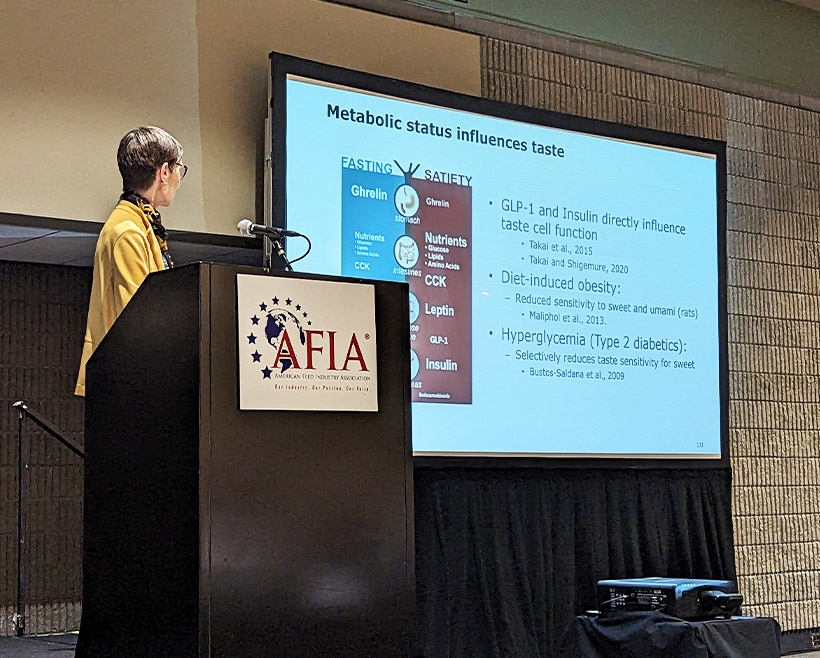This is the second in a series of two articles covering a presentation by Nancy Rawson, Ph.D., on “The Flavor World of Companion Animals.” Learn more about pets’ sensory systems in our first article, “Understanding flavor through a pets’ eyes, nose and mouth.”
ATLANTA — Pets’ sensory systems are complex and dynamic. The perceptions derived from experiencing taste and smell change over time, and these perceptions are intimately related to an animal’s overall health. Moreover, a decline in health could result in a decline in or alteration of perception.
“The importance of odor in particular for flavor perception cannot be underestimated,” said Nancy Rawson, Ph.D., acting director and president at Philadelphia-based Monell Chemical Senses Center. “There are a lot of things you really can’t discriminate if you don’t have a sense of smell… I think loss of interest in food is a big issue with aging or with diseases that cause loss of smell.”
In her presentation at the American Feed Industry Association’s (AFIA) 2023 Pet Food Conference, held Jan. 24 in conjunction with International Production & Processing Expo (IPPE) in Atlanta, Rawson shed light on the anatomy behind flavor perception and how health concerns such as inflammation, aging and stress can have a deleterious effect on these sensory systems.
The flavor-health connection
There are several factors — both internal and external — that can affect flavor perception. From an evolutionary standpoint, these sensory systems respond to survival needs as well as each animal’s unique experience or environment.
“The ability to detect, discriminate and identify odors depends on genetics, experience and health,” Rawson said. “For odors in particular, sensitivity and preference can shift over time.”
The receptor cells in the taste and olfactory pathway have the ability to regenerate throughout an animal’s lifetime. However, the ability to replace these cells diminishes as pets age, and this aging process can have deleterious effects on overall health and wellness.
“Fewer receptor cells translate to less sensitivity. Less sensory input to the brain — and this is the newest research — can influence cognitive function directly and generally,” Rawson noted. “It turns out that with olfactory, auditory and other types of sensory input, the less sensory input, the nerve cells in the brain start to lose connections and starts to show effects on cognitive performance.”
 Nancy Rawson, MSc, Ph.D., acting director and president at Monell Chemical Senses Center, presents at the American Feed Industry Association's 2023 Pet Food Conference on Jan. 24. | Source: Sosland Publishing Co. / Jordan Tyler
Nancy Rawson, MSc, Ph.D., acting director and president at Monell Chemical Senses Center, presents at the American Feed Industry Association's 2023 Pet Food Conference on Jan. 24. | Source: Sosland Publishing Co. / Jordan Tyler According to Packaged Facts, more than half (55%) of dog-owning households in the United States owned a dog that was 7 years old or older in 2021. The share of US households owning senior pets rose from 45% in 2014 to 55% in 2021.
Domesticated dogs and cats are living longer and longer — and that’s a good thing. But, as these pets enter their golden years, keeping their health and wellness in check becomes increasingly crucial.
“Our pet population is aging, and diabetes is quite high, particularly in the United States,” Rawson said. “It turns out that metabolic status influences our taste system in a very direct way. Under fasting and satiety, regulatory hormones [such as GLP-1 and insulin] shift up and down and receptors for many of these hormones are present on the taste cells. In particular, GLP-1 and insulin directly influence taste cell function. In diet-induced obesity, where animals are put on a high-fat diet and become obese, there is reduced sensitivity to sweet and umami perception. In hyperglycemia, such as seen in Type 2 diabetics, there is a selective reduction in the sensitivity for sweet. These effects are due in part to the direct effects of these hormones on those taste cells.
“This is also true for olfaction — insulin modulates the activity of the olfactory system’s ability to detect odors,” she added. “Under lower insulin, we see greater sensitivity. When there’s excess insulin, such as in morbid obesity, there’s poor sensitivity. So, when you think about obese and diabetic cats and dogs, their flavor perception is going to be quite different from a healthy animal.”
Obesity, diabetes, aging and stress are all causes of inflammation. While some inflammation can be beneficial — meaning the body is actively protecting itself against harmful hazards— chronic inflammation can affect a dog or cat’s taste and olfactory systems and, in turn, impact their perception of flavor. Inflammation can cause dysregulation of sensory pathways for taste and smell, which can result in tissue damage and changes in gene expression that are more harmful than helpful.
“What we see in obesity, for instance, is a chronic elevation of these pro-inflammatory chemicals, and that partly contributes to the development of diabetes and a lot of those health consequences,” Rawson said.
“The stress hormone — the glucocorticoid receptor — is present on taste cells,” she added. “So, taste cells also have the receptor that is being directly affected by stress. If you look at the effects of stress on receptor proteins and receptor cell function, we see that there’s dramatically less T1R3 — one of the components of both the sweet and umami (MSG) receptors. Also, they’re showing reduced sensitivity to sweet and MSG.”
Rawson also noted that recent research by Monell scientists has shown that social anxiety stress can reduce the number of mature taste cells and result in decreased taste sensitivity in mice.
“The other piece of this is that aroma and taste contribute to physiological responses to food and the release of digestive enzymes and insulin that the body needs to properly process the nutrients,” Rawson said. “So, if you’re missing those sensory components of the food experience, your metabolism and your digestion are not going to be as optimally responsive to the food that’s coming in to get the most nutritional value out of it, and that’s a physiological consequence that has a negative impact.”
Emerging research is shedding light on how flavor could impact metabolism. According to Rawson, specialized taste receptor cells called solitary chemosensory cells are located throughout the body, including in the gastrointestinal tract. These cells detect chemicals and taste compounds present in foods but, instead of communicating taste, they help “mount the proper response” inside the body.
“For instance, in the gut, these cells can detect chemicals that are released by parasites,” she said. “When they sense a high level of these chemicals, they trigger the gut motility to help expel the parasite.”
These chemical sensory systems extend to food and how the body reacts to what is eaten. This means if a pet’s taste system is damaged — through disease, aging, stress or other health hazards — their metabolism may not respond appropriately.
“One of the good pieces of information that’s come out in the more recent past is that the best way to promote healthy aging, with respect to the senses, is to use them,” Rawson said. “…The same is true with our olfactory sense.”
Repeat exposure of a disliked taste or smell can reduce the unpleasantness of that stimulus. This is likely due to effects both in the periphery and the brain, as we learn that a bitter taste is not toxic, for instance. For example, Rawson noted that odor-sensing cells typically are replaced periodically from stem cells. If these cells are activated regularly over time, they can have more longevity — up to several months. If those cells and pathways aren’t regularly activated, on the other hand, they have a reduced lifespan of about 30 days.
“The exposure of an odor increases the prevalence of neurons sensitive to that odor,” she explained. “…A smell expressing a particular odor receptor helps to promote the generation of more cells like itself. It likes having friends. So, our environment subtly shapes the sensory capacity of the system to be most effective for those aromas that are most relevant to our daily activities.”
Aside from repeat exposure, Rawson suggested offering pets (and people) a variety of olfactory experiences can also help extend the breadth of sensitivity throughout their lifetimes — ultimately resulting in a more attuned sensory system. Presenting pets with a variety of tastes, smells and textures, especially at a young age, can support sensitivity to certain stimuli and even influence food preferences and tolerances.
Rawson said she is most concerned about the effect of stress on sensory systems, both in pets and people. Early research points to severe, gene-altering consequences of stress, and more research is needed to better understand this phenomenon.
"Stress is really changing our taste and our olfactory systems in a pretty fundamental way," said Nancy Rawson, Ph.D., Monell Chemical Senses Center.
“I want to reemphasize the effect of stress,” Rawson said. “We’ve had so much stress over the last couple of years. People are stressed, and then when people went back to work, their pets were stressed, and we just kind of take it for granted that it’s sort of a transient kind of thing. What we’re seeing are changes at the genetic level and in the expression of genes and the cellular level that are frightening. Stress is really changing our taste system and our olfactory systems in a pretty fundamental way.
“This is an area for the industry to consider both in terms of different types of products and different ways of educating the pet owners, to really think about this problem, because it’s going to exacerbate all of the negative health effects of obesity and longevity and other health issues,” she added. “I hope that the industry can really take it to heart and think about what they might do to help — we know that pets help reduce stress in people, so let’s help reduce stress in pets, too.”
Pets’ sensory systems, similarly to those in people, come with a caveat: “use it or lose it.” These systems are inextricably linked to cognitive, behavioral, metabolic and physiological health, and taking a big-picture approach is crucial to keeping pets healthy and happy throughout their lifetimes.
“Keep your nose and mouth healthy to be healthy, and vice versa,” she concluded.
This is the second in a series of two articles covering a presentation by Nancy Rawson, Ph.D., on “The Flavor World of Companion Animals.” Learn more about pets’ sensory systems in our first article, “Understanding flavor through a pets’ eyes, nose and mouth.”
Read more about product development, ingredients and formulation.



